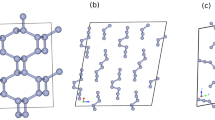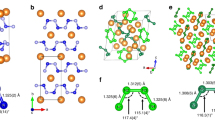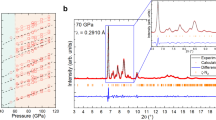Abstract
Nitrogen, one of the most abundant elements in nature, forms the highly stable N2 molecule in its elemental state. In contrast, polynitrogen compounds comprising only nitrogen atoms are rare, and no molecular crystal made of these compounds has been prepared. Here, we predict the existence of such a molecular solid, consisting of N8 molecules, that is metastable even at ambient pressure. In the solid state, the N8 monomers retain the same structure and bonding pattern as those they adopt in the gas phase. The interactions that bind N8 molecules together are weak van der Waals and electrostatic forces. The solid is, according to calculations, more stable than a previously reported polymeric nitrogen solid, including at low pressure (below 20 GPa). The structure and properties of the N8 molecular crystal are discussed and a possible preparation strategy is suggested.
This is a preview of subscription content, access via your institution
Access options
Subscribe to this journal
Receive 12 print issues and online access
$259.00 per year
only $21.58 per issue
Buy this article
- Purchase on Springer Link
- Instant access to full article PDF
Prices may be subject to local taxes which are calculated during checkout





Similar content being viewed by others
References
Vij, A. et al. Experimental detection of the pentaazacyclopentadienide (pentazolate) anion, cyclo-N5−. Angew. Chem. Int. Ed. 114, 3177–3180 (2002).
Cacace, F., de Patris, G. & Troiani, A. Experimental detection of tetranitrogen. Science 295, 480–481 (2002).
Ostmark, H. et al. Detection of pentazolate anion (cyclo-N5−) from laser ionization and decomposition of solid p-dimethylaminophenylpentazole. Chem. Phys. Lett. 379, 539–546 (2003).
Samartzis, P. C. et al. Two photoionization thresholds of N3− produced by ClN3 photodissociation at 248 nm: further evidence for cyclic N3−. J. Chem. Phys. 123, 051101 (2005).
Hansen, N. et al. Photofragment translation spectroscopy of ClN3 at 248 nm: determination of the primary and secondary dissociation pathways. J. Chem. Phys. 123, 104305 (2005).
Christe, K. O., Wilson, W. W., Sheehy, J. A. & Boatz, J. A. N5+: a novel homoleptic polynitrogen ion as a high energy density material. Angew. Chem. Int. Ed. 38, 2004–2009 (1999).
Haiges, R., Schneider, S., Schroer, T. & Christe, K. O. High energy density materials. Synthesis and characterization of N5+P(N3)6−, N5+B(N3)4−, N5+HF2−nHF, N5+BF4−, N5+PF6− and N5+SO3F−. Angew. Chem. Int. Ed. 43, 4919–4924 (2004).
Lauderdale, W. J., Stanton, J. F. & Bartlett, R. J. Stability and energetics of metastable molecules: tetraazatetrahedrane (N4 ), hexaazabenzene (N6 ), and octaazacubane (N8). J. Phys. Chem. 96, 1173–1178 (1992).
Bartlett, R. J. Exploding the mysteries of nitrogen. Chem. Ind. 4, 140–143 (2000).
Fau, S. & Bartlett, R. J. Possible products of the end-on addition of N3− to N5+ and their stability. J. Phys. Chem. A 105, 4096–4106 (2001).
Fau, S., Wilson, K. J. & Bartlett, R. J. On the stability of N5+N5−. J. Phys. Chem. A 106, 4639–4644 (2002).
Nguyen, M. T. Polynitrogen compounds. 1. Structure and stability of N4 and N5 systems. Coord. Chem. Rev. 244, 93–113 (2003).
Hirshberg, B. & Gerber, R. B. Decomposition mechanisms and dynamics of N6: bond orders and partial charges along classical trajectories. Chem. Phys. Lett. 531, 46–51 (2012).
Mailhiot, C., Yang, L. H. & McMahan, A. K. Polymeric nitrogen. Phys. Rev. B 46, 14419–14435 (1992).
Mattson, W. D., Sanchez-Portal, D., Chiesa, S. & Martin, R. M. Prediction of new phases of nitrogen at high pressure from first-principles simulations. Phys. Rev. Lett. 93, 125501 (2004).
Wang, X., Tian, F., Wang, L., Cui, T. & Liu, B. Structural stability of polymeric nitrogen: a first-principles investigation. J. Chem. Phys. 132, 024502 (2010).
McMahan, A. K. & LeSar, R. Pressure dissociation of solid nitrogen under 1 Mbar. Phys. Rev. Lett. 54, 1929–1932 (1985).
Eremets, M. I., Gavriliuk, A. G., Tro jan, I. A., Dzivenko, D. A. & Boehler, R. Single-bonded cubic form of nitrogen. Nature Mater. 3, 558–563 (2004).
Eremets, M. I., Hemley, R. J., Mao, H. & Gregoryanz, E. Semiconducting non-molecular nitrogen up to 240 GPa and its low-pressure stability. Nature 411, 170–174 (2001).
Gerber, R. B. Formation of novel rare-gas molecules in low temperature matrices. Annu. Rev. Phys. Chem. 55, 55–78 (2004).
Sheng, L. & Gerber, R. B. Predicted stability and structure of (HXeCCH)n (n = 2 or 4) clusters and of crystalline HXeCCH. J. Chem. Phys. 126, 021108 (2007).
Perdew, J. P., Burke, K. & Ernzerhof, M. Generalized gradient approximation made simple. Phys. Rev. Lett. 77, 3865–3868 (1996).
Grimme, S. Accurate description of van der Waals complexes by density functional theory including empirical corrections. J. Comput. Chem. 25, 1463–1473 (2004).
Dion, M., Rydberg, H., Schröder, E., Langreth, D. C. & Lundqvist, B. I. Van der Waals density functional for general geometries. Phys. Rev. Lett. 92, 246401 (2004).
Giannozzi, P. et al. Quantum Espresso: a modular and open-source software project for quantum simulations of materials. J. Phys. 21, 395502 (2009).
Chai, J-D. & Head-Gordon, M. Long-range corrected hybrid density functionals with damped atom–atom dispersion interactions. Phys. Chem. Chem. Phys. 10, 6615–6620 (2008).
Shao, Y. et al. Advances in methods and algorithms in a modern quantum chemistry program package. Phys. Chem. Chem. Phys. 8, 3172–3191 (2006).
Acknowledgements
Research at the Hebrew University of Jerusalem was supported under the auspices of the Saerree K. and Louis P. Fiedler Chair in Chemistry (R.B.G.). A.I.K. acknowledges support from the Army Research Office (grant W911NF-12-1-0543). B.H. and R.B.G. wishes to thank S. Aflalo for her help with the artwork for the manuscript.
Author information
Authors and Affiliations
Contributions
B.H. performed the calculations. A.I.K. provided advice on electronic structure calculations. R.B.G. proposed the research topic. B.H., A.I.K. and R.B.G. contributed to the interpretation of the results and co-wrote the manuscript.
Corresponding author
Ethics declarations
Competing interests
The authors declare no competing financial interests.
Supplementary information
Supplementary information
Supplementary information (PDF 1049 kb)
Rights and permissions
About this article
Cite this article
Hirshberg, B., Gerber, R. & Krylov, A. Calculations predict a stable molecular crystal of N8. Nature Chem 6, 52–56 (2014). https://doi.org/10.1038/nchem.1818
Received:
Accepted:
Published:
Issue Date:
DOI: https://doi.org/10.1038/nchem.1818
This article is cited by
-
A polymeric nitrogen N\(_6\)–N\(_2\) system with enhanced stability at low pressure
Scientific Reports (2022)
-
Stabilization of hexazine rings in potassium polynitride at high pressure
Nature Chemistry (2022)
-
Predicting the crystal structure of \(\hbox {N}_5\hbox {AsF}_6\) high energy density material using ab initio evolutionary algorithms
Scientific Reports (2021)
-
The Raman and IR vibration modes of metal pentazolate hydrates [Na(H2O)(N5)]·2H2O and [Mg(H2O)6(N5)2]·4H2O
Journal of Molecular Modeling (2020)
-
Strategy for chemically riveting catenated nitrogen chains
Journal of Molecular Modeling (2019)



